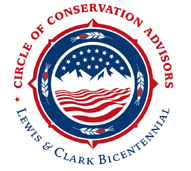
The Lewis and Clark Expedition of 1803-1806 was a major event that shaped the future of the lands, rivers, animals, natural resources and people within what is now called the United States. The expedition provides us with the first scientific descriptions of 178 trees and plants and 122 animals, journalistic images of abundant wildlife, vast prairies, pristine rivers, mountains and forests, and natural history lessons learned from the indigenous tribes that met them. It is the mission of the Circle of Conservation Advisors to commemorate and acclaim the conservation story that is a critical part of examining and learning from the Corps of Discovery.
In cooperation with the Council and its partners, state, federal, and all tribes and tribal governments that had contact with the expedition, other tribes throughout the United States, and all interested individuals, the Circle of Conservation Advisors promotes educational programs that examine, clarify or promote discussion of what has been lost as well as what is still left of the pristine and wild America that is our natural heritage. To establish a lasting Lewis and Clark conservation legacy, we identify and promote opportunities to restore land, rivers and habitat throughout the areas Lewis and Clark traveled so that native fish and wildlife continue to inhabit the Lewis and Clark Trail and so that many generations to come will have the opportunity to explore these lands with the same sense of excitement Lewis and Clark felt 200 years ago.


